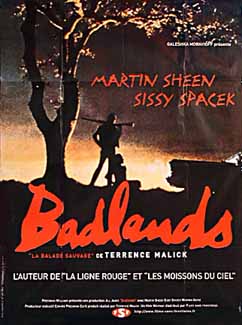
BADLANDS
US, 1973, 94 minutes, Colour.
Martin Sheen, Sissy Spacek, Warren Oates, Alan Vint.
Directed by Terrence Mallick.
Badlands was the first film of writer director Terrence Mallick. It was a very successful debut, but not entirely popular with entertainment-seeking audiences. The story of a young thug, a mixture of naive geniality and selfish cruelty, and of the lonely, plain young girl who tells the tale, its details seem just right. The characters are puzzling, yet plausible, the overtones of American violence ugly but real, the misguided bid for glory in a clutching at gangster notoriety. Beautiful photography, a blend of classical and contemporary musical styles and excellent performances by Martin Sheen, seen so successfully in many television films and, especially, Sissy Spacek who was notable in Carrie and Three Women, make this a film to be recommended for serious cinemagoers.
1. The significance of the title and its meaning? The Badlands as a place, a symbol, a place to die? How was the symbol visualised. and explored?
2. What was the main impact of the film? Comment on its technical aspects; the use of location photography, colour, the build-up of incidents, the various symbols, the motifs associated with the couple, Holly's narrative, the themes of youth, drifting, thrill killing, the cult of youth? Comment on the use of music: the modern styles, the classical styles, the poetic use of the music.
3. How successful was the integration of the film as regards plot, themes, techniques? Critics consider it a classic.
4. What was the audience's basic response to Kit and Holly? Were they likeable in any way? Why were they unlikeable? How involved did the audience become in their activities? How involved by? being repelled? The involvement of the audience closely in their amoral attitudes, their callousness, their killing, their love and their estrangement, their seeking for fame and celebrity? What emotional reaction from the audience?
5. The importance of death in the film? The callousness of the murders and the way they were visualised; the shooting of Holly's father, the slow death of Kater, his running away and Holly's conversation with him, the complete callousness of shooting the couple in the hole, the shooting of the bounty hunters? Why didn't Kit and Holly consider the risks to themselves? Why did they kill? The meaning of life and death for them? The meaning of life and death for the audience and, hence, audience response to this killing?
6. The portrayal of Holly; the value of her narrative: The almost emotionless commentary, the poetic insights, the lack of morality? The judgement on Holly, especially at the end when she separated from Kit and went her own way? What kind of girl was she? Her relationship with her father, a girl at fifteen, why was she fascinated with Kit? Her lack of looks and attractiveness? Wanting a purpose for her life? Her resentment towards her father and the shooting of the dog? Her lack of reaction to his death? Immature girlish reaction to Kit and to the murders? Her relishing the life in the trees and in nature? Her response to nature? How attractive were her good traits, for example, her talking to Kato? Her reaction to the dead couple? To the rich man's car? Why did the rift grow between herself and Kit? Why did she not stay? Her reaction to Kit's being captured? What future did she have? Was she portrayed in the film as a real person or as a symbol?
7. How central was Kit for the success of the film? The initial portrayal in the town, on the garbage run? What kind of young man of the 50s? The James Dean overtones? His age, the direction of his life, his lack of values, his wanting to be someone, the psychotic aspects of his personality? His living in his own world, his attraction towards Holly, his taking her away, his showing off to her? Audiences response to his killing of Holly's father? His enjoyment of life in the forest, his sexuality and relationship with Holly? The callous killing of the hunters, his friendship with Kato and yet killing him, the gratuitous killing of the couple? His taking of the rich man's car? The exhilaration of the chase for him, the defiance of the law, was it important that Holly was not with him? His enjoyment of being captured? His wanting fans and glory? What insight into a psychotic character did this portrayal give? The nihilistic approach to life and death? The irony that he did not die but lived?
8. How important were other people in the film: Holly's father, life at home, his painting the billboard? The hunters and the fact that they were killed so quickly? Kato as a friend? The innocent couple? The police?
9. How were the aims of the filmmakers achieved? This film as a comment on life and values?
10. How important were the details for the film: the garbage run, the speeding of the suicide tape, the setting of the house on fire and the distancing of it in the music, life in the forest, the hunters, the open lands, the way the couple were shot, the sex stone and its memorial, their souvenirs. the use of newsreels etc.?
11. This film was based on fact. How horrifying is this? Is it necessary to make films like this to give insight into this type of personality? As a comment on society?